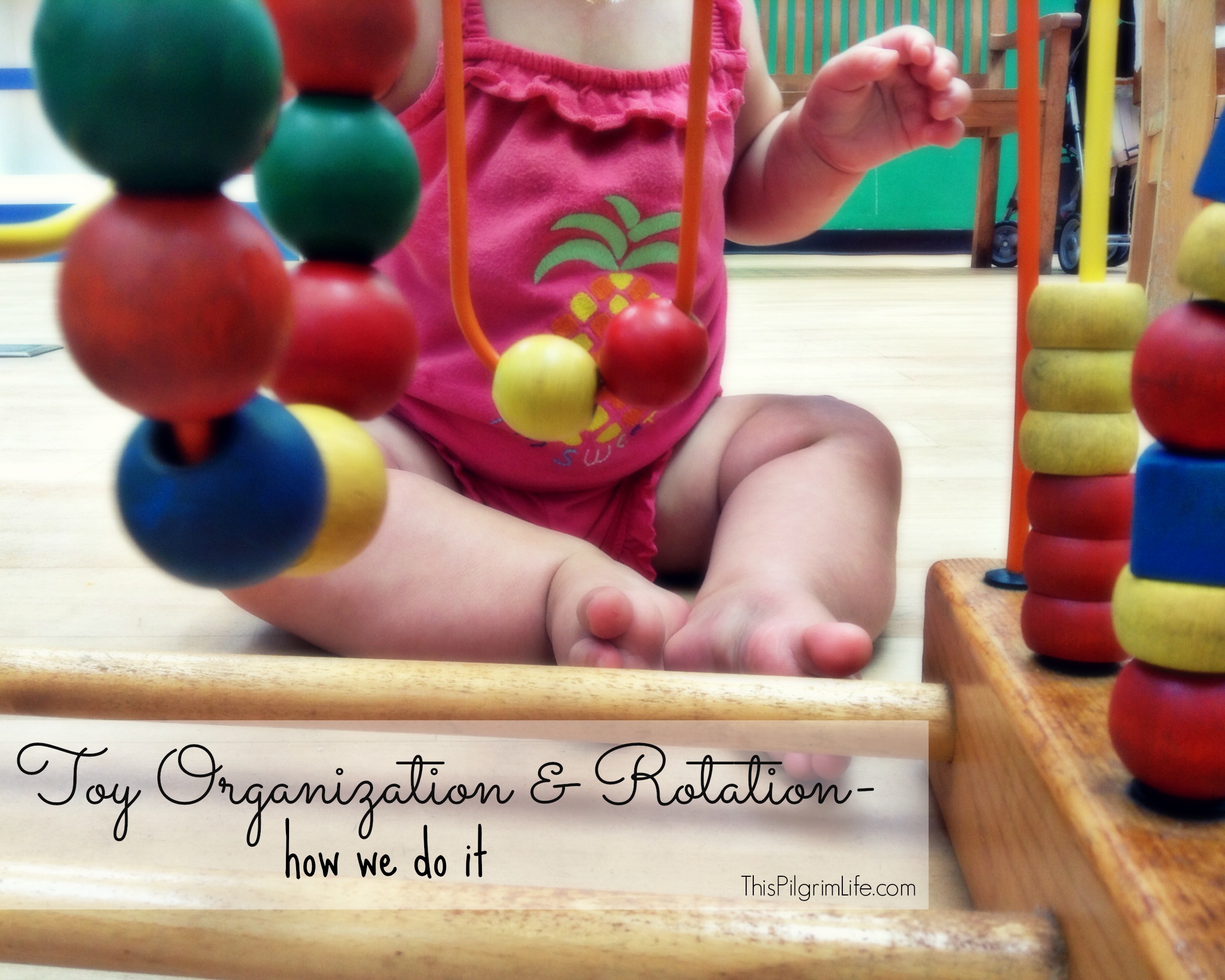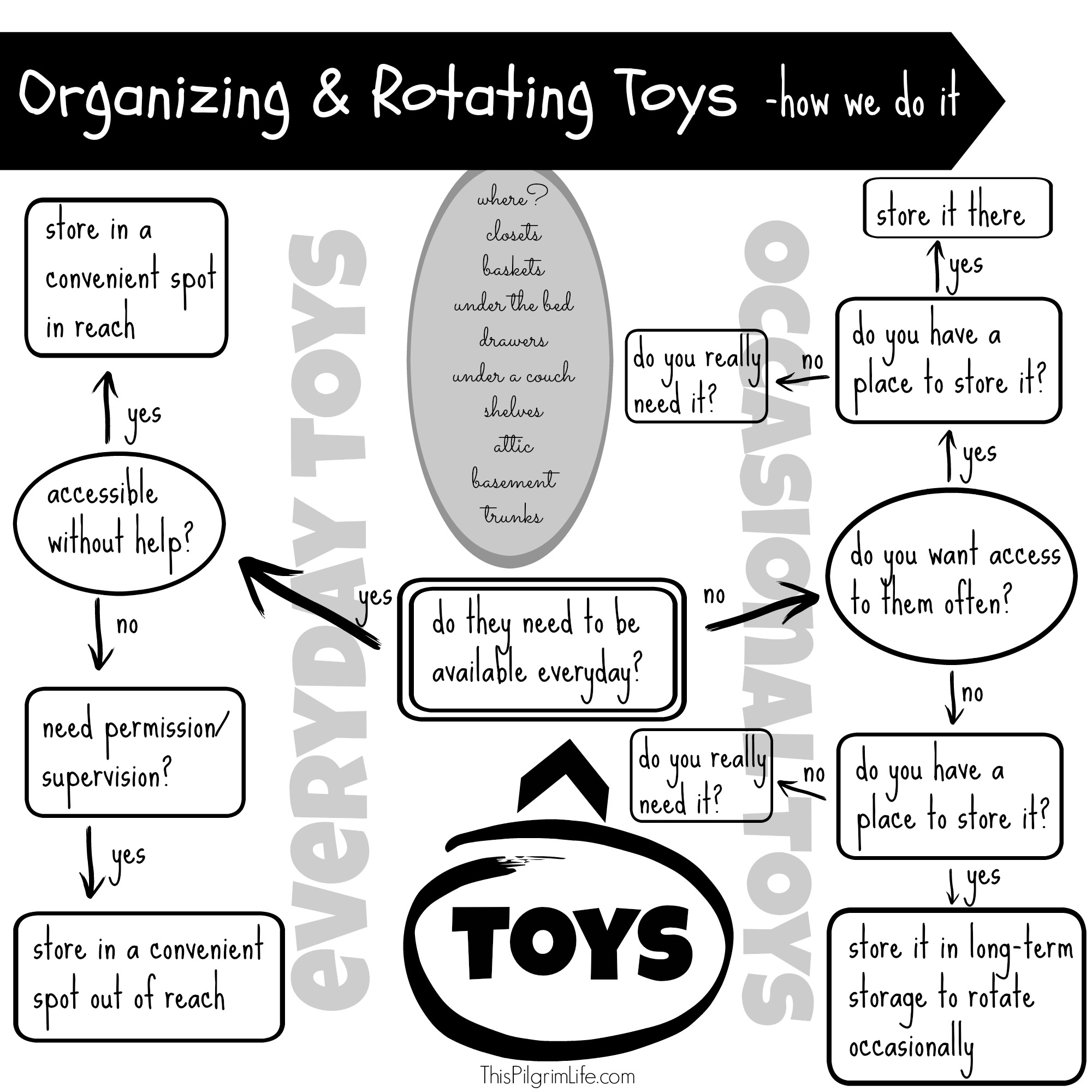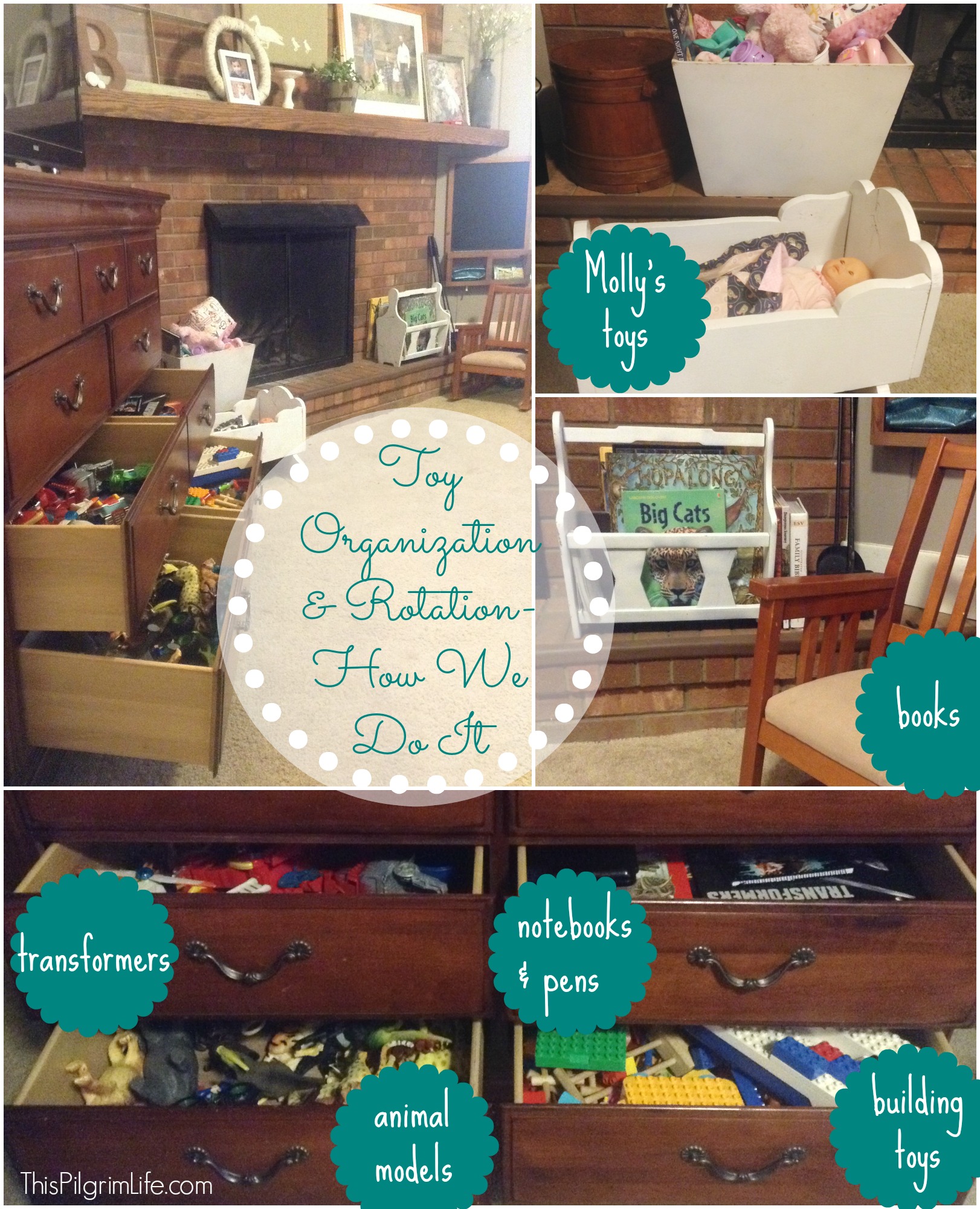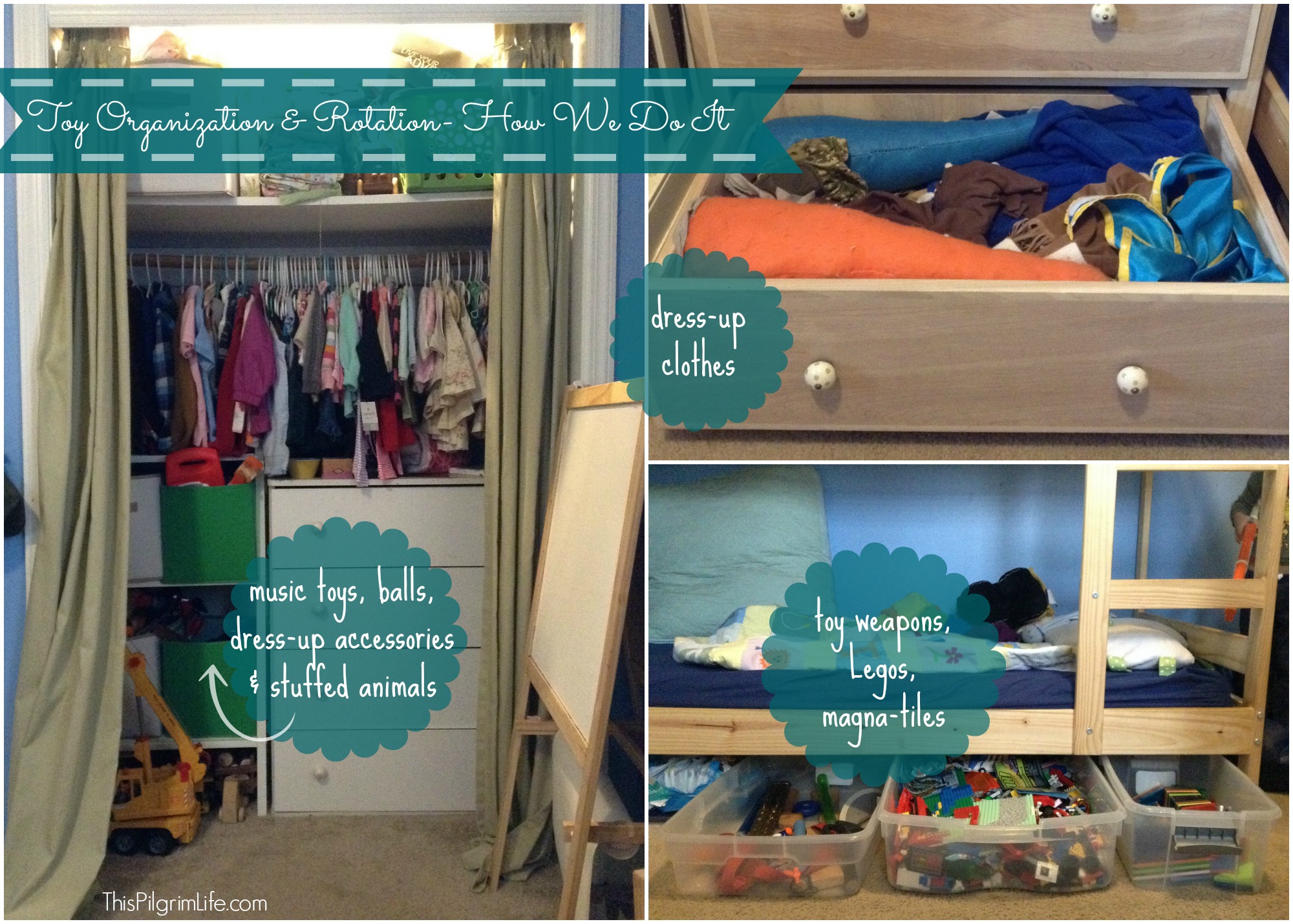I have been asked by several friends and readers recently about how we organize and rotate toys in our home. And since we are only a couple of weeks past The Big Day of Acquiring New Things and in the season of Organize All The Things, I thought I would take some time to share what we do.
This post actually has taken a lot longer to write than I originally anticipated. In part, this is due to writing while watching Gilmore Girls and being sucked into the drama therein.
And in part due to is writing and rewriting and then editing again trying to find the right balance between coherently explaining and over-explaining. There is not anything especially amazing in what follows, but it is what works for us right now and I hope that maybe it can at least give a few new ideas or inspiration to you for getting all your kids’ stuff in order.
Currently in my home I have a baby, a toddler, and a preschooler. They have stuff. Their stuff is all over the house. Toys in the kitchen. Toys in the bathroom. Legos under your feet and plastic bugs in your purse (that’s not just my purse, is it???).
The toy sprawl is a fact of life.
It’s inevitable with kids. Those kids having interests. Those kids with interests have parents who like to give good gifts. Those kids with interests who have parents also have parents who especially like to buy gifts.
Despite best intentions and plans to avoid excessive toy accumulation, the toys they just keep on a’coming.
Here is how I have managed to keep the toy sprawl from taking over our home:
In the past, I have rotated through multiple bins of toys during the year. The bins were either full of extra toys or toys that were not age appropriate at the time. Then, this past year I got rid of a lot of toys. A.LOT.OF.TOYS. And after my big toy pare down, there were no longer enough extra toys to fill so many bins.
So now we have a hybrid system of rotating certain toys and keeping what is left out well organized…
Toy Organization & Rotation… Keeping Things Simple In 3 Easy Steps
1. {Significantly} Reduce the toys in your home.
Because the toys keep on a’coming, a purge two or three times a year an essential step in keeping toy organization under control.
Like I already mentioned, I pared down my kids’ toys earlier this year. I’ve found that the more children we have, the more discriminating I am about what is worth keeping around. For example, even though we hope for another baby in the future, I have gotten rid of almost all the baby toys. They just aren’t necessary when there is a house full of other toys and kitchen tools and so on that are plenty entertaining to a baby/toddler.
When deciding on what to keep, I focus on these four things:
- Is it good quality? (toys that are made well, that are not broken or missing important pieces)
- Is it something that all my children can enjoy? (open-ended toys that can be played with together and that span age and gender differences)
- Does it encourage imagination, learning, and/or discussion? (problem-solving, role playing, learning based, relationship building, etc)
- Do we already have one or more similar toys? Do we need so many? (Do you need six different types of building blocks? Four tea sets? Twenty stuffed animals that rarely are played with?)
Anything that does not fit these criteria gets passed on or thrown out. Of course, I make exceptions for toys that hold special significance or that my children especially enjoy. But more often than not, the toys that we part with are not missed at all.
2. Sort the remaining toys.
At this point, I separate the remaining toys into groups. (Maybe even paring down the toys even further!)
For each group I determine which category they fit into:
- Toys I want to be accessible without help
- Toys my kids need permission and/or supervision with
- Toys my kids like to play with everyday toys
- Toys that are occasional or to be rotated
Now that we no longer have enough little toys to fill bins to rotate through like we had done before, almost all of their toys are available to play with everyday.
The toys that we do rotate are large toys that require more floorspace or toys that are single-use (like a cash register). Rotating these toys works well because it keeps the toy sprawl down (since everything left out can be put away out of sight) and means that they are still exciting and novel when we pull them out. When I do pull out one of these toys, I typically only leave them out for a few days because that’s usually all it takes for my kids to enjoy it and move on again. (Pulling out one of the big, special toys is also a great idea for rainy days or when mom isn’t feeling so good).
What this looks like at our house:
Everyday toys. Accessible without asking. Building toys, model animals, dress-up clothes and accessories, toy weapons, and my baby daughter’s toys.
Everyday toys. Permission/supervision needed. Legos, art supplies.
Occasional toys. Long-term storage. toy barns, large fire station with furniture and figures, play kitchen, cash register, marble run, play sports thingy (that’s actually the technical word).
Occasional toys. Short term-storage. Puzzles, games, music toys, various balls, certain art supplies.
3. Find storage that works.
My personal preference is to have most toys stored so that when they are cleaned up they are out of sight. Just as important is keeping the toys in a location that makes them convenient to get out and easy to put away.
I’ve tried a lot of different methods for organizing toys, from fabric boxes on shelves, to big toy bins, keeping toys under the bed, and sorting them in dresser drawers.
What has worked well for us is to store the toys separated into each type. Easier to find what you’re looking for and easier to clean up. (Teaching kids to pick up what they finish with before getting something new out has helped us keep the house *mostly* tidy).
We recently switched things up in our living room and moved a large dresser up from the basement to keep our television. The drawers have made the perfect storage for my kids’ toys and homeschool supplies. A box of Molly’s toys and a book bin on the fireplace round out all the toy storage outside of my kids’ room.
In the kids’ room, they have a few under-the-bed containers for their toy weapons, Legos, and magna-tiles. Any other toys or art supplies they have are kept organized in a couple of closets. And we are fortunate to have a basement and an attic, so we store all the occasional toys in one or the other.
The trick is just finding a method that works with the space and resources you have. Get creative and be open to unconventional methods of organization.
Baskets, trunks, closet shelves, under-the-bed containers. I’ve even used box tops from paper boxes to store toys under the bed when funds weren’t available for new containers. Goodwill is a great place to look for deals on storage options. And Costco (a contender with Goodwill for my favorite store) always has plastic totes– big, small, and sliding– for a reasonable price.
As with so many things, there are endless ways of dealing with toys that families have made work for them. How many, what kinds, what they do with them– it’s all freedom and personal preference. How do you deal with toy sprawl in your house? What helpful tips can you share?




Hi Lisa, I must say you are an incredible writer. This is a very useful blog. Most of the people always think to store toys but they don’t do. This blog will be helpful for them. Thanks for sharing!
Hey Lisa,
Just stumbled upon this researching for toy storage ideas myself and really enjoyed reading!
A great guide and some actionable tips on how to actually control the madness!
We just recently had a clear out of about 2 years of toys and its amazing how much clutter can build up. I admire your organisational skills!